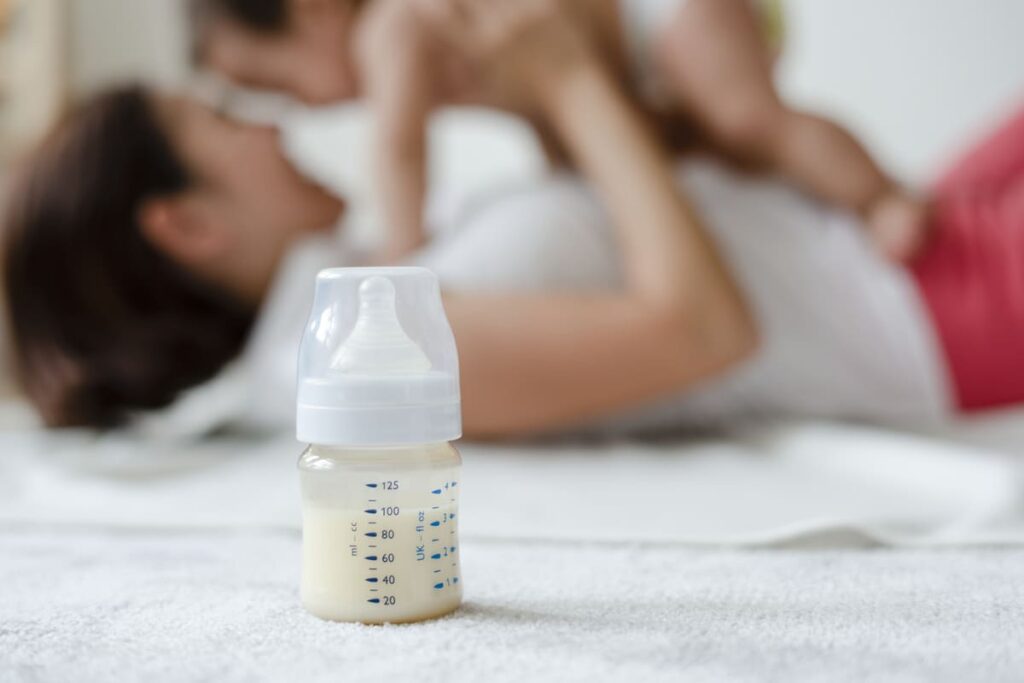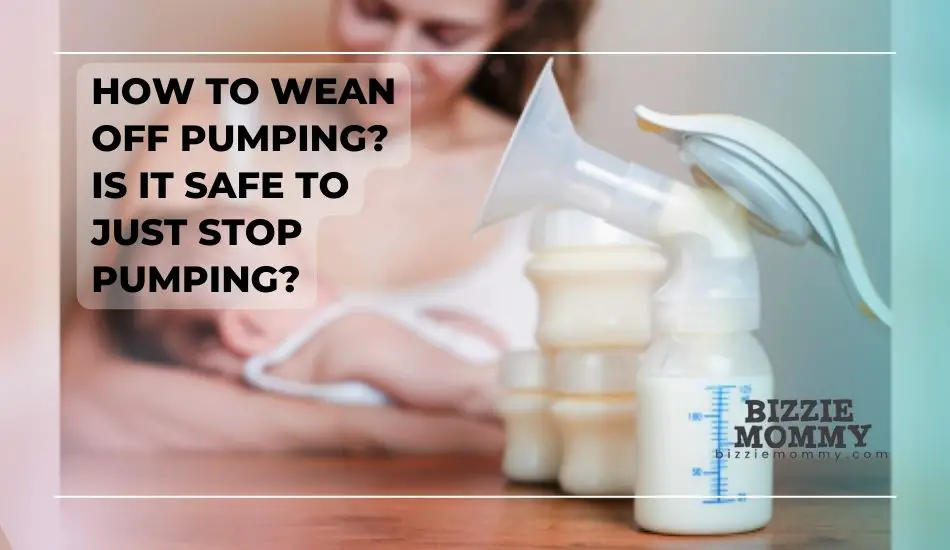So you’re a mother who has been exclusively pumping breast milk and now it is finally the time to let go of your arch nemesis, the breast pump, but you’re unsure about how to wean off pumping. Are you scared of getting infections, clogged ducts, and mastitis? Well, look no further as we’ve got you covered! Here we showcase helpful tips that might help you wean from the pump without the hassle!
In simple terms, weaning off pumping can take about a week or two. Do not wean off quickly or suddenly stop pumping cold turkey! With a sudden halt, you might end up with engorged breasts or even mastitis. Make sure you lengthen the time intervals between your pumping sessions as you start weaning from the pump, or gradually reduce the time of each pumping session. You can use breast binders or a supportive bra to help you transition easily.
How to Stop Pumping Breast Milk?
Pumping is not something that most mothers love and there might come a time when you’d like to stop pumping or maybe shift to breastfeeding or feeding solids as your child grows.
There are a handful of ways you can wean off the pump without the risk of clogged ducts and mastitis, which can occur in mothers who stop weaning cold turkey.
What Naturally Dries up Breast Milk?
Now you might be wondering what causes clogged ducts once you stop pumping. Well, this is because the breast milk inside your breasts stays in your mammary ducts if you hasten your use of the pump. This might result in engorged breasts and eventually mastitis.
To prevent this, your body undergoes a process called lactation suppression. This process refers to the act of drying up your breast milk by reducing its production.
Some people do not want to breastfeed their newborns or might be transitioning from exclusively pumping to complementary feeding, and they might want to dry up their milk supply.
This is possible with some natural herbs, but also be sure to check with a lactation consultant who might be able to help. Here are some natural ways to dry up your breast milk:
Cabbage Leaves
Some studies suggest that long-term use of cabbage leaves may help suppress lactation, resulting in reduced milk production. You can apply chilled cabbage leaves to your breasts when you put on a bra and change every hour or so. This might help you reduce the chances of breast engorgement.
Using Sage or Peppermint
A 2014 study suggests that sage-containing teas might help dry up breast milk, but make sure you consult a doctor before starting and try a small amount to check your body’s reaction. Other herbs include parsley, peppermints, and jasmine, the latter of which can be applied topically over the breasts.
Some of these herbs might affect your child, so consult your healthcare provider before you start this method.
Vitamin B
High doses of vitamin B complex might help you dry up your breast milk if you are planning to stop pumping or milking. But do keep an eye out for the possible side effects of using such vitamins for a long period.
Off-Label Drugs
Drugs such as cabergoline or contraceptive pills might help you halt your breast milk production, but keep in mind that these drugs are not allowed by the FDA for this purpose, hence the term “off-label.”
If you are skeptical about these options, we’ve got other ways you can skip your breast-pumping sessions.
Binding Your Breasts or Wearing a Supportive Bra
Throughout history, wrapping the breasts has helped women to dry up their milk. However, this comes with many side effects. A better option is to wear a supportive bra which might help relieve the pain in your breasts.
Getting Pregnant
Though not as dependable, this method might help mothers reduce their breast milk supply. A study suggests that breast milk production decreases during the second trimester of pregnancy, specifically the fourth and fifth months.
Hand Expression
If you feel that your breasts are full and you do not want to pump, try to use your hands to express until your breasts feel less painful. With this method, you need to maintain a good balance between not allowing your breasts to become engorged but also not expressing too much milk.
How Long does it Take to Wean off Pumping?
With no rules set in stone, the time to wean from the pump varies invariably from mother to mother. For some, it might take as long as a month to reduce their milk supply, while for others, it could take only one to two weeks to wean from the pump.
On average, it takes around two to four weeks to completely wean from the pump. The time it takes for you to wean depends upon a handful of factors such as your milk supply, history of clogged ducts or mastitis, prescription drug use, and lifestyle and work-life balance.
What is The Best Way to Stop Pumping?
Weaning from the pump should be done gradually to avoid possible complications. Here are some helpful tips that can help you wean from the pump:
Shorten Pumping Sessions
The idea is to not completely drain your breasts. This can be done by reducing the pumping time by one-fourth. That is, if your usual pumping session lasts for twenty minutes, reduce it to fifteen minutes.
If you’ve been pumping three to four ounces of milk, you might decrease the amount per session to two ounces, but keep it at this rate for at least a few days.
Keep in mind that to avoid clogged milk ducts, you might have to slow down the transition. Keep the time of your pumping sessions at this stage for a week or so, and then slowly reduce even more.
Your body will get the hint that your breasts are not being emptied to the full extent, resulting in reduced milk production.
Increase the Time Between Pumping Sessions
You can start by increasing the time between pumping sessions per your comfort. You can delay up to thirty minutes or an hour, but remember to increase the time gradually.
Keep in mind that pushing sessions back won’t get you far; rather, you might end up feeling full, eventually resulting in clogged ducts and infection.
Dropping Pumping Sessions
Lastly, you can slowly transition to dropping pumping sessions, but with the idea of timing other sessions with the same interval in between. For example, if you have been pumping seven times a day, you might want to decrease it to six times.
Gradually decrease the number of pumping sessions until you have no sessions left for a day, but keep in mind to not rush it, as you might end up with clogged milk ducts.
Is it Okay to Just Stop Pumping?
Though not recommended, some people might have to abruptly stop pumping, which might cause them to develop clogged ducts and mastitis. It is usually recommended to stop pumping slowly to gradually decrease milk production.
Milk in your breasts tends to build up if you abruptly stop pumping or fail to express milk on a consistent basis. This ends up inflaming your ducts and your breasts become tender, engorged, and warm.
This can be brought about by increasing the time between pumping sessions or dropping sessions eventually. The process takes time and patience, so do not rush it!
You might use a supportive bra or place chilled cabbage leaves inside your bra to help dry up the milk quicker. Though this might help you avoid engorgement, it could also trigger sulfa allergy in prone people. Herbal tea containing sage might help decrease milk production and dry up your milk, but there is not much evidence to support this theory.
Will my Milk Supply Decrease if I Stop Pumping?

Pumping stimulates your breasts the same way nursing your child might stimulate milk production. But this doesn’t mean that whenever you stop pumping, your milk vanishes. It gathers in your ducts if you do not express it regularly.
So how can you decrease your milk supply? While an abrupt halt in the expression of milk, either through pumping or nursing, might end up in engorged breasts, a gradual decrease in milk expression would surely help you reduce your milk supply.
To avoid engorgement of breasts that could lead to mastitis, you might use home remedies to make this transition smooth and pain-free!
How Long Will my Breasts Hurt After I Stop Breastfeeding?
When you stop pumping or breastfeeding, milk production may not stop immediately. Milk collected inside your breasts tends to clog ducts.
The milk in these clogged ducts might end up inflaming the breast tissue nearby, resulting in swollen, tender breasts.
This breast pain might last for a few days or even weeks. Try to gradually transition from exclusively pumping to no pumping so that your body gets the time to adjust.
You might experience the following changes when you stop pumping or breastfeeding:
Pain In the Initial Days of Weaning
You might feel pain in the brown area surrounding your nipple, known as the areola. Breast pain could occur in both breasts simultaneously but tends to gradually decrease with time.
Tightness and Fullness
With milk engorging your breast tissue and ducts as a consequence of a sudden halt in pumping, you might feel that your breasts are full and tight. Gradually decreasing pumping or breastfeeding might help avoid this complication.
Flu-Like Symptoms
These include shivers and chills at night. Moreover, you might experience lassitude and anxiety as well as a general feeling of unwellness.
Lumpy Breasts
With inadequate or no milk expression, you might end up engorging your breasts. Milk might collect in the form of small cysts inside your breasts, appearing as lumps.
Engorged breasts are at risk of getting infected, which is called mastitis. This inflammation might eventually result in a breast abscess which is a collection of pus sitting inside your breast tissue.
Final Thoughts
If it is time for you to finally let go of your breast pump and you’re worried about the possible side effects of stopping cold turkey, know that it is possible to avoid most of the complications and you can smoothly wean from the pump.
It usually takes a few weeks to months to wean from the pump, but it depends on the mother and her lifestyle. Most people take two to four weeks to wean from the pump and might experience a few side effects.
Patience is key, so try to go slow and gradually increase the time between pumping sessions, first by a few minutes and eventually dropping sessions. You can combine this with gradually reducing the time of pumping sessions as well.
It is important to give your body time to adjust to the new changes and transition slowly through the process of weaning from the pump.
Along with this, you can use a variety of home remedies to dry up your milk. Chilled cabbage leaves and sage teas might help you decrease milk production and you could end up weaning earlier without the risk of clogged ducts.
If you feel tightness or tenderness in your breasts, you might have developed mastitis, which is the inflammation of breast tissue. It might be a consequence of inadequate milk expression while weaning from the pump, so remember to not fully express the milk until your breasts are empty.
If you have a fever and your breasts are red and tender, seek assistance from a lactation consultant as soon as possible to rule out any possible complications.

